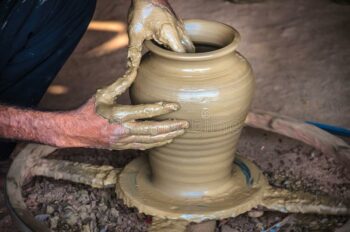By Jeff Girard –

About 10 years ago, my wife Cathy surprised me with the present of a pottery wheel. She knows that I like to make things, and had dabbled in clay while in college, so she thought it would be a good fit.
And, it has been. I started by taking a class, then worked through years of mastering the process. We put it in a shed in my backyard and built a little pottery studio.
Nowadays I think of myself as an intermediate potter…I get a mix of mess-ups, pretty OK pieces and once in a while, something I’m truly proud of.
And while it’s always nice to have your work come out of the kiln in one piece and looking good, there’s a lot more to ceramics than the finished products. I have learned a lot about myself along the way and often muse on the “biblical” nature of the craft. The action involved in making a pot is essentially the same today as it was in Jesus’s time and in the early old testamental period.
The first thing a potter does when throwing on the wheel, is to center the hump of clay. This is usually one of the most difficult things for beginners to learn…the clay seems to have a mind of its own. If you’ve seen people do this, you know that it’s accomplished by pushing up and in on the hump.
Easier said than done
An experienced potter makes it look easy. That’s because they know the principle of locking in. To do this, as you sit in front of the wheel, with the hump spinning before you, you anchor your arm into your abdomen and push through your forearm to contact the clay. Using the weight of your whole body to push keeps the clay from simply throwing your arm out of place. If you try to do this without locking in, your hands will wobble around, pushing the hump out of shape and making everything more off centered than before.
As you lean into the clay, your locked in arm provides the reference plane for the outside of the hump. Then, your remaining hand pulls the clay from the opposite side, up and in. The idea is to raise the clay up, making the hump taller and narrower, which makes it easier to form…less mass to push against. Then, once the clay pile is tall, your hands can move to the top, to push straight down, while keeping it all in the center of the wheel. Do this cycle a couple of times and your clay will be nicely centered and ready to open up.
Opening involves pushing a small space in the very center of the top of the hump, and then increasing that opening until you have formed a bottom floor and side walls. This creates a cylinder, the starting point of almost all wheel-thrown vessels.
Then, using that outside guiding hand holding firm, you reach in with the other hand and push the inner side of the wall out. This is how the potter raises the walls, thinning them as they work. Experience tells the craftsman how far to go, because if you thin the walls too much your vessel will collapse; not enough and you have a thick, heavy piece.
This is why that first step, centering, is so important. Poorly centered humps lead to irregular thickness in the walls, throwing the whole piece off and producing a wobbling form that wants to go really bad, really quickly. So while it can be time consuming and painstaking to get the hump centered at the beginning, it makes no sense to continue without it.
God forms us
Isaiah 64: 8 says “O Lord, you are our Father, we are the clay and you are the potter. We are formed by your hands.”
I think of God’s hands that form us as justice and mercy.
The outside arm is justice…it’s locked in to be solid, immovable, positionally correct. A firm foundation for reckoning the whole mass. It’s like the Word of God, a locked-in reference for everything that is to come. It uses the weight of the Maker’s wisdom and power to set the work rightly.
But without that other gentle mercy hand, pulling the clay toward the lock-in, nothing would happen. The mercy hand feels the weight and pliability of the material and exerts just enough pressure to bring it all into place. Through it, the Potter informs the clay of what He has in mind, easing it along until it begins to conform to the maker’s will. It’s done with forethought and intention, and with a vision of the final vessel in mind.
So, justice and mercy work “hand-in-hand” to achieve a balanced result.
Look through the Bible and you will find many references to the tension between God’s mercy and His justice.
Deuteronomy 32:4 says “He is the Rock, his works are perfect, and all his ways are just. A faithful God who does no wrong, upright and just is he”
We are humbled by the thought of a just, righteous God, who has no room for impurity or off-centeredness. He requires true vessels, nothing out of balance, true to the form he intends. How can we—lumpy, blobby impure lumps of clay—ever become the fine ware that he intends?
But it is well for us that His lovingkindness and mercy are as powerful as his justness. Gentle but no less strong and eternal, He shapes artfully and with the intent that each will serve a valuable function.
In Psalm 145:9 David said about God: “The Lord is good to all, and His mercies are over all His works”
…like thumbprints, we see the presence of God in us as we reflect His workmanship. The marks of the Maker’s fingers are evident.
2 Corinthians 4: 7: “But we have this treasure in jars of clay to show that this all-surpassing power is from God and not from us”
Like a luminaria, we have an external form, but with open spaces to reveal the light within. We hope that the luminance of the spirit is bright.
“ Let your light so shine before men, that they may see your good works, and glorify your Father which is in heaven.” Matthew 5: 16



